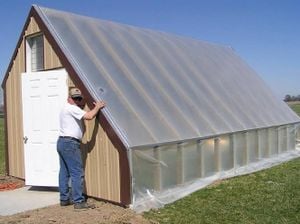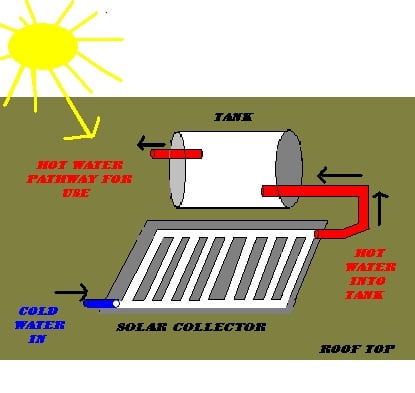m (Requirements for a house to be considered a passive house) |
(removing content which refers to passivhaus / passive house and leave a hat note to prevent this mixup in future.) |
||
| Line 1: | Line 1: | ||
{{topic header|Passive water heater diagram 2 (2).jpg|Passive solar}} | {{topic header|Passive water heater diagram 2 (2).jpg|Passive solar}} | ||
{{hatnote|Not to be confused with [[Passive House PassivHaus / Passive House]] which is a performance-based energy standard in construction}} | |||
[[File:Building-a-passive-solar-greenhouse.jpg|thumb|left|A passive solar [[greenhouse]].]] | [[File:Building-a-passive-solar-greenhouse.jpg|thumb|left|A passive solar [[greenhouse]].]] | ||
| Line 22: | Line 23: | ||
**A shallow glass-fronted closet, lined with dark material, becomes very hot when exposed to the sun. One-way valves (which might be as simple as plastic sheet over wire mesh) allow cool air to enter at the bottom and hot air to exit at the top. They can be used for heating hot water, as well as for space heating. | **A shallow glass-fronted closet, lined with dark material, becomes very hot when exposed to the sun. One-way valves (which might be as simple as plastic sheet over wire mesh) allow cool air to enter at the bottom and hot air to exit at the top. They can be used for heating hot water, as well as for space heating. | ||
*When these measures are appropriately utilized and combined the energy efficiency of a building can be much higher than with more conventional design measures. | *When these measures are appropriately utilized and combined the energy efficiency of a building can be much higher than with more conventional design measures. | ||
== External links == | == External links == | ||
* [http://www.ourcoolhouse.com/podcast/OurCoolHouse-Pasive_Solar_Design.mp3 Passive Solar Design] (MP3 audio file). Clear and basic explanation from the [http://www.ourcoolhouse.com/podcast/ OurCoolHouse Podcast] | * [http://www.ourcoolhouse.com/podcast/OurCoolHouse-Pasive_Solar_Design.mp3 Passive Solar Design] (MP3 audio file). Clear and basic explanation from the [http://www.ourcoolhouse.com/podcast/ OurCoolHouse Podcast] | ||
{{Solar navbox}} | {{Solar navbox}} | ||
Revision as of 17:25, 6 January 2019

Passive solar design is the harnessing or directing of solar energy through non-mechanical, non-electrical means. It is a key principle of green building, often applied in designing buildings for maximum solar heating during cold winter months and maximum protection from the sun's heat during hot summer months.
Key building design techniques include:
- Planting deciduous trees or trellises covered in deciduous or annual vines. This may be as a fence or as a shade roof, and provides shade in summer and light and warmth in winter.
- Designing and building components with consideration for the seasonal change in the sun's position in the sky, and the influence this will have on the angle and intensity of light hitting the structure. Examples of this include:
- Broad eaves, which block sunlight from entering windows during the summer, but allows it to enter during the winter when the sun is lower in the sky.
- Shade walls (less common)
- A wall or fence beyond the limits of the house, to provide shade. The wall runs east-west, on the east and/or west side of the house, and is on the north side of the house in the northern hemisphere, and on the south side in the southern hemisphere (i.e., away from the equator). The angle and placement are calculated to shield the house from early morning or late afternoon sun in summer but not in winter. However, this requires significant resources and, unless there are other reasons for a wall, it is generally better to use other methods, such as deciduous trees, or an awning, especially where there are large windows.
- Thermal mass Thermal mass is a critical component of any passive solar design. Its purpose is to absorb and re-radiate heat energy. This has the effect of averaging out the daily extremes of high and low temperature. Thermal mass generally falls into two categories, passive and active. Passive thermal mass heat-storage systems include:
- Thick masonry walls and floors
- Phase-change materials
- These materials change phase (typically from solid to liquid) when heated, storing a great deal of heat energy without a corresponding change in temperature. Examples include various high-tech concrete additives and also natural resins, such as those found in Southern Yellow Pine.
- Large liquid storage tanks inside the space to be heated (or cooled)
- Pipes to transfer heat between air and the thermal mass (e.g., in the ground under the house, either with natural convection or with a quiet low-power fan)
- White roofs
- Dark roofs absorb large amounts of solar energy, which transfers into the building. This increase in absorbed heat requires increased electrical energy to remove and cool buildings, homes, and workplaces and maintain a comfortable environment. Dark colors also radiate heat more easily in cold conditions, meaning greater heat loss from buildings and higher heating costs.
- White surfaces have an increased albedo or "whiteness," which is the reflectivity of a surface. If a roof is more reflective less energy will be absorbed and transferred to the building.
- Solar closets
- A shallow glass-fronted closet, lined with dark material, becomes very hot when exposed to the sun. One-way valves (which might be as simple as plastic sheet over wire mesh) allow cool air to enter at the bottom and hot air to exit at the top. They can be used for heating hot water, as well as for space heating.
- When these measures are appropriately utilized and combined the energy efficiency of a building can be much higher than with more conventional design measures.
External links
- Passive Solar Design (MP3 audio file). Clear and basic explanation from the OurCoolHouse Podcast
